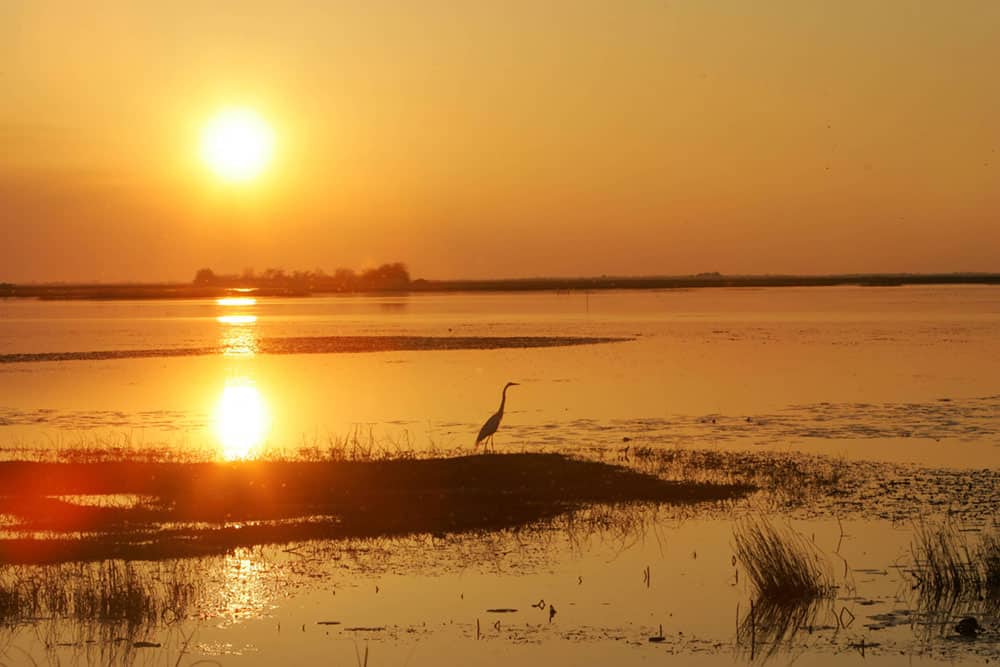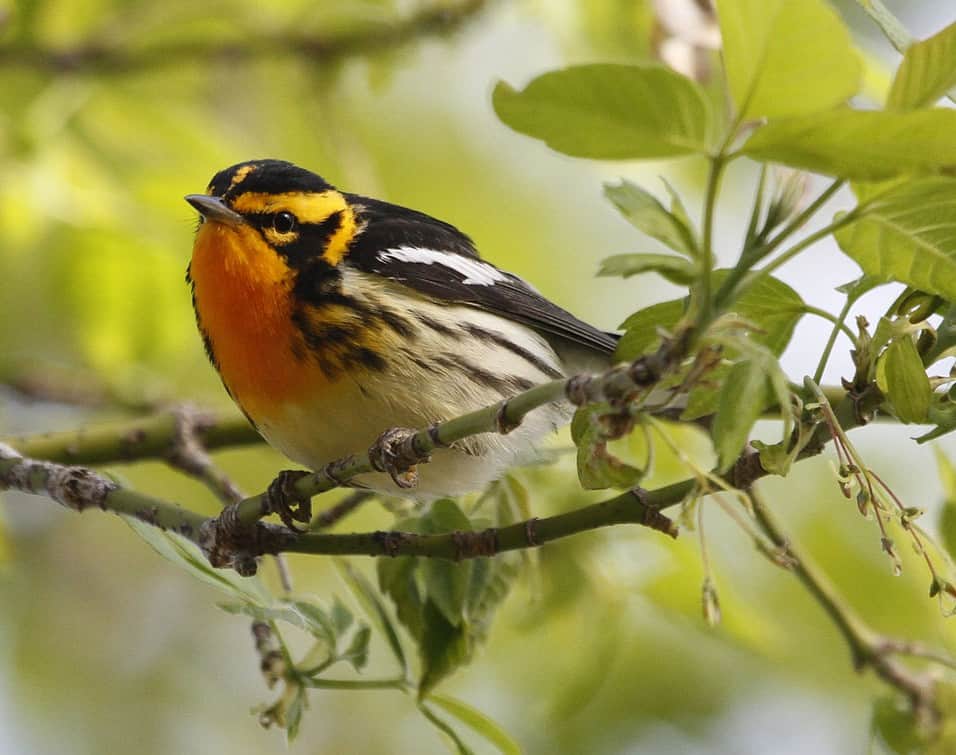Hawk Ridge Nature Reserve in Duluth
P.O. Box 3006
Duluth, MN 55803
(218) 428-6209
Hawk Ridge is likely Minnesota’s most famous birding site and for good reason. Some of Minnesota’s best-watched birds fly over Hawk Ridge. The National Audubon Society has named Hawk Ridge an Important Birding Area. On September 15, 2003, 102,329 raptors were counted passing over Hawk Ridge. A sight like this is one of the reasons that Minnesotans say “Uffda!” a lot. The record total on that famed day included more than 101,000 broad-winged hawks.
The vastness of Lake Superior creates a natural barrier that birds are reluctant to fly over and this causes southbound migrants to funnel over Hawk Ridge. Flocks (kettles) of hawks ride the updrafts or warm air that form along the ridges running parallel to the shore of the lake.
Cold fronts with winds from the northwest or west make for impressive numbers of birds, with the peak migration typically in mid-September. October is a good time to see bald and golden eagles, red-tailed hawks, and northern goshawks. Most of the hawks tend to fly past during the first couple of hours after sunrise, and the activity slows down in mid-afternoon. There are not a lot of raptors on the wing on rainy and foggy days or on days when the wind is calm.
Blue Mounds State Park
1410 161 St.
Luverne, MN 56156
(507) 283-1307
An exposed rock 100 feet high and 1.5 miles long that appeared blue in color to settlers heading west gave this 1,800-acre park its name. Blue Mounds State Park, mostly prairie and grassland, lies on top of a large outcrop of Sioux quartzite.
Located in Rock County in the southwestern corner of the state, Blue Mounds State Park is the only truly reliable place in the state to find a southern specialty species, the blue grosbeak. Look for Savannah, swamp, clay-colored, and grasshopper sparrows, bobolink, Swainson’s hawk, gray partridge, American woodcock, upland sandpiper, black-billed and yellow-billed cuckoos, eastern screech owl, orchard and Baltimore orioles, yellow-headed blackbird, western meadowlark, sedge wren, willow flycatcher, and dickcissel here.
To interest any non-birding companions traveling with you, there is a resident bison herd at Blue Mounds State Park, and the bulls can be observed sparring for mating dominance in July.
Sax-Zim Bog
St. Louis County
Author Joseph Hickey wrote this about birding, “By some it is regarded as a mild paralysis of the central nervous system, which can be cured only by rising at dawn and sitting in a bog.” Many a birder has said that if they could only bird in one spot in Minnesota, they would choose Sax-Zim Bog.
Located in St. Louis County, this accessible, conifer bog offers nesting great gray owl, Connecticut warbler, gray jay, upland sandpiper, sharp-tailed and ruffed grouse, yellow-bellied flycatchers, evening grosbeaks, and boreal chickadees. Other summer possibilities include pine and golden-winged warblers, white-crowned, clay-colored, Le Conte’s, and white-throated sparrows, sedge and winter wrens, alder flycatcher, and black-billed magpies. The great gray owl is a year-round resident in this 200 square mile mix of spruce, cedar and tamarack bogs. During the winter, the bog is a good place to look for great gray, northern hawk, and snowy owls, northern goshawks, redpolls, grosbeaks, crossbills, black-backed woodpeckers, and northern shrikes.
Sax-Zim is named for its proximity to two small towns that are, coincidentally, named Sax and Zim.
Directions: From Eveleth go 4.3 miles on Hwy 53 south to Hwy 37. Turn right on Hwy 37 heading west for about 3.8 miles to County Road 7. Turn left heading south on C.R. 7, and travel 13.1 miles to Sax. This is the heart of the Sax-Zim Bog. Watch closely for wildlife. (Travel the listed county and gravel roads to explore the area including C.R. 28, C.R. 788 & C.R. 213).
Agassiz National Wildlife Refuge
22996 290 St.
Middle River, MN 56737
(218) 449-4115
Established in 1937 in Marshall County, this 61,500-acre refuge is a great place to find shorebirds during migration, especially when the pools are in drawdown (low water levels).
Pools, marshes, grasslands and woodlands provide a home for sandhill cranes, Nelson’s sharp-tailed and Le Conte’s sparrows, short-eared owl, sedge wren, five species of grebes, American bittern, American woodcock, Franklin’s gull, black tern, black-billed magpie, northern harrier, whip-poor-will, and yellow-headed blackbird.
There is a very large nesting colony of Franklin’s gulls at Agassiz. In an average year, 250 pairs of Canada geese and 7,500 pairs of ducks nest at Agassiz. Eared, western, and red-necked grebes, black-crowned night-herons, and black terns nest here.
The best time to observe ducks is May through mid-June. Franklin’s are here gulls from May through mid-July. Sandhill cranes are present from late April through early May and late September through mid-October. Shorebirds are here from mid-May to the end of May and sparrows from mid-to-late May.
McGregor Marsh
Aitkin County
Located from McGregor 2 miles S on MN Hwy 65 on E side of highway.
McGregor Marsh is an extensive marshland in the former bed of the glacial Lake Aitkin. It contains the specific habitat requirements for the yellow rail and the Nelson’s sharp-tailed sparrow, two highly sought-after species for Minnesota bird watchers.
This sedge marsh is the most consistent spot in Minnesota to see and hear the yellow rails that nest there. The sound of this bird, like that of two small stones being tapped together, can be heard at night. June is the best time to see and hear the yellow rail.
It would be a good idea to come equipped with both a strong spotlight and strong mosquito repellent.
McGregor is a good place to search for other birds such as American bittern, Le Conte’s, swamp, and Savannah sparrows, sedge and marsh wrens, Wilson’s snipe, and bobolink.
Big Stone National Wildlife Refuge
44843 County Road 19
Odessa, MN 56276
(320) 273-2191
Located in Big Stone and Lac Qui Parle counties in extreme west central Minnesota, and straddling the headwaters of the Minnesota River, Big Stone has 11,521 acres of marshes, woods, lakes, prairies, and fields. The wide variety of habitats makes for a wide variety of birds. This is a magical place during spring and fall bird migration.
Big Stone has been designated a Globally Important Bird Area by the American Bird Conservancy. The refuge is a major migratory stopover for more than 20 species of waterfowl. It supports large numbers of least, stilt and pectoral sandpipers.
Birds you might see at Big Stone NWR include snowy and cattle egrets, western grebe, short-eared, long-eared, and northern saw-whet owls, loggerhead shrike, grasshopper, clay-colored, and Le Conte’s sparrows. In addition, look for bobolink, Swainson’s hawk, American woodcock, American white pelican, sedge wren, common nighthawk, marbled godwit, orchard oriole, willow flycatcher, greater prairie-chicken, least bittern, upland sandpipers, and lack- and yellow-billed cuckoos.
There is an auto tour trail available for easy access to good and comfortable birding.
Sherburne National Wildlife Refuge
17076 293 Ave.
Zimmerman, MN 55398
(763) 389-3323
A location with varied habitat (prairie, oak savanna, wetlands, and woodlands, among others), Sherburne NWR is a good place to look for golden-winged and blue-winged warblers, whip-poor-will, eastern meadowlark, lark, field, clay-colored, Savannah, and grasshopper sparrows. Great egret, eared grebe, red-headed woodpecker, yellow-throated vireo, American redstart, gray partridge, upland sandpiper, indigo bunting, dickcissel, northern harrier, and nesting sandhill cranes are also part of the seasonal birdlife at Sherburne. Bald eagles, black terns, Virginia rails, and soras nest here in or near the wetlands. Northern shrikes are known to winter at Sherburne, no doubt attracted by the diversity of wintering songbirds.
This 30,665-acre Refuge in the St. Francis River Valley of Sherburne County provides an 8-mile auto tour where you can spot wildlife from the comfort of your car. Its location just 50 miles northwest of the Minneapolis/St. Paul metropolitan area makes it a popular birding destination. As with Minnesota’s other 9 national wildlife refuges, access may be restricted during hunting seasons.
Frontenac State Park
29223 County 28 Blvd.
Frontenac, MN 55026
(651) 345-3401
Frontenac State Park is located along the wooded bluffs in Goodhue County, 450 feet above an expanse of the Mississippi River called Lake Pepin. The diverse habitat found here includes oak savanna, woodlands, wetlands and a lake.
Frontenac has had a well-deserved reputation for bird watching since the 1800’s. In the fall, you can see migrating hawks (sharp-shinned, broad-winged and red-tailed). Eagles and turkey vultures soar over the bluffs. It is a traditional spring site for birders. It’s a good migrant trap with as many as 27 species of warblers being seen in a single day. The 2,773-acre park contains floodplain forest, oak woodland, bluff prairie, grassland, and maple-basswood forest. Prothonotary warbler, yellow-throated vireo, bald eagle, and American redstart nest here.
Other species to look for at Frontenac include wild turkey, clay-colored, grasshopper, and Savannah sparrows, rose-breasted grosbeak, hermit thrush, orchard oriole, scarlet tanager, ruddy turnstone, Acadian flycatcher, blue-winged warbler, Louisiana waterthrush, yellow-bellied sapsuckers, bobolinks, sedge wrens, eastern meadowlarks, and Bell’s vireos. Henslow’s sparrows and cerulean warblers are possibilities, too.
Sand Point offers opportunities to observe shorebirds, terns, gulls, and waterfowl. The tree-lined walk to Lake Pepin offers the chance to see prothonotary warbler and pileated and red-headed woodpeckers.
Gunflint Trail
PO Box 790
Grand Marais, MN 5564
(218) 387-1750
The Gunflint Trail in northeastern Minnesota is located within the boundaries of Superior National Forest and is an outstanding destination for birding. The American Bird Conservancy named the Superior Forest one of 500 Globally Important Bird Areas.
It’s a reliable place to look for black-backed, three-toed, and pileated woodpeckers, northern saw-whet, boreal, and northern hawk owls, alder, olive-sided and yellow-bellied flycatchers, spruce grouse, boreal chickadee, and gray jay. Burned areas in the Gunflint are one of the best places in the state to look for black-backed woodpeckers.
This is one of the very best spots to experience the delights of warbler watching, with at least 15 warbler species that nest here in summer.
Good Harbor Bay, just to the east of Grand Marais, is a good place to see long-tailed ducks, loons, and scoters from October to May.
Grand Marais is a grand place to bird in the fall with a chance to see such birds as common and hoary redpolls, Townsend’s solitaire, and Bohemian waxwing. Winter brings an opportunity to enjoy the beauty of pine grosbeak, red-breasted nuthatch, pine siskin, and redpolls.
Itasca State Park
36750 Main Park Drive
Park Rapids, MN 56470
(218) 266-2100
Itasca originates from the Latin words “veritas caput,” meaning true head. It’s in this park where the mighty Mississippi River begins its 2,552-mile journey to the Gulf of Mexico. It is possible for a visitor to walk across the source of the mighty river here.
Itasca State Park is Minnesota’s first state park, begun in 1891 and includes more than 100 lakes. It’s a beautiful spot situated in Clearwater and Hubbard Counties offering 300-year old pines and good birding with a great variety of northern species. The 32,000-acre park of pine, spruce, aspen, birch, lake and bog offers red-breasted nuthatch, winter and sedge wrens, common loon, common tern, American white pelican, hermit and wood thrushes, brown creeper, northern parula, ovenbird, mourning warbler, ruffed grouse, barred owl, pileated and black-backed woodpeckers, northern goshawk, broad-winged hawk, bald eagle, evening grosbeak, gray jay, alder and least flycatcher.
The American Bird Conservancy has named Itasca State Park an Important Birding Area.




